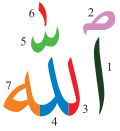Arabic alphabet
| Use of the Arabic alphabet in the world | |
|---|---|
| → Countries where the Arabic script is the only script used officially | |
| → Countries where the Arabic script is used with other scripts | |
The Arabic alphabet, otherwise referred to as the Arabic abjad, is an abjad that is used to write several languages of the Middle East such as Arabic, Persian, Pashto and Urdu. The script is the third most widely used script in the world, after the Latin and Chinese scripts.
| Arabic abjad | |
|---|---|
 | |
| Type | Abjad |
| Spoken languages | Arabic, Persian, Baloch, Urdu, Kurdish, Pashto, Sindhi, Malay and others |
| Time period | 400 CE to the present |
| Parent systems | |
| Unicode range | U+0600 to U+06FF U+0750 to U+077F |
| ISO 15924 | Arab (#160) |
| Note: This page may contain IPA phonetic symbols in Unicode. | |
Overview
The script is written from right to left. When it is used to write the Arabic language, the script has 31 different letters. Usually only consonants are written in an abjad. Vowels are omitted most of the time. The Arabic script is a cursive script. This means that letters of a word are joined together, both in handwriting and in print. Each letter can have up to four different forms. Which of the forms is used depends on the letters before and after it. There is no different form for uppercase letters and lowercase letters.
There are two basic modern variants of the Arabic script. One is called Naskh, it is the one commonly used for printing. The most common script in everyday life is called Kufic, after the city Kufa, in Iraq, where it was developed. There are several variants of both scripts.
Numbers
The alphabet can also be used to write numbers, which was common in the Middle Ages. They are less used today and usually replaced by Latin-alphabet (Arabic) numbers.
When the alphabet is used to write numbers, hamzah (ء) is 0, ʼalif (ا) is 1, bāʼ (ب) is 2, gīm (ج) is 3 and so on. That is sometimes used to produce chronograms in which specific letters, interpreted as numerals, stand for a particular date when they are rearranged.
Sort order
For dictionaries, it is necessary to put the letters into a predetermined sequence, which is usually called sort order, or alphabetical order. The Arabic script has two sort orders: The one, abjid, derives from the position of the letters in the Phoenician alphabet. The other, hijā, sorts letters by similarity of shape.
History
As Islam spread throughout the Middle East, North Africa, and Asia, Arabic spread along with it. Islam requires its followers to learn Arabic because it states that Gabriel (Jibril) spoke the words of Allah to Muhammad in Arabic. The language is used for Muslim rituals such as prayer and the reciting of Quranic verses. As Arabic spread, the Quran's script also spread. It replaced the Pahlavi writing system as Islam conquered Persia.
Another alphabet, the Uighur alphabet, was based on the shapes of Arabic letters. However, the Uighur alphabet always has vowel letters, unlike in Arabic.
After the fall of the Ottoman Empire during the First World War, use of the Arabic language and alphabet, became less common in the Muslim world. The Turkic states and other Muslim-majority states controlled by the Soviet Union did not favour Arabic script. In 1928, Turkey passed a law that banned the use of the Arabic alphabet for writing Turkish, which is now written with the Latin alphabet.
Around the same time, the Soviet Union created a Latin alphabet for the Central Asian states that it occupied: Azerbaijan, Kazakhstan, Turkmenistan, Uzbekistan, Kyrgyzstan, and Tajikistan. The decision to replace the Arabic alphabet was mostly to remove religious influence in Central Asia and to modernise the region. For a time, Soviet leaders, including Vladimir Lenin, believed the Latin alphabet was the "world alphabet" because it was the writing system of most developed countries. However, the Soviet Union then required the Central Asian states to write only in the Cyrillic script. That was to influence local cultures and languages to become more like those of Russia.[1]
After the Dissolution of the Soviet Union, none of the Central Asian nations returned to using the Arabic alphabet. They either kept using the Cyrillic, like Kazakhstan and Kyrgyzstan, or adopted a new Latin alphabet, like Azerbaijan. Only Tajikistan is considering switching back to using the Arabic alphabet. Tajik was once a dialect of Persian.
In Southeast Asia, Malaysia, Indonesia, Singapore, and Brunei have adopted for Malay the Latin alphabet, which is called Rumi in Malay. The British and Dutch colonialists introduced the Latin alphabet. The Arabic alphabet (Jawi in Malay) is still used in Malaysia but much less than Rumi. Brunei is the only Southeast Asian country in which both the Latin and Arabic alphabets are co-official.
Arabic Alphabet Media
Components of a ligature for "Allah": 1. alif2. hamzat waṣl (ْهَمْزَة وَصْل)3. lām4. lām5. shadda (شَدَّة) 6. dagger alif (أَلِفْ خَنْجَریَّة) 7. hāʾ
A page from the manuscript of Al-Kamil's book on the making of the northern and southern astrolabe and their reasons for geometry and arithmetic by Ahmed bin Katheer Al-Farghani, where the letters appear in red in an arranged order expressing numbers.
Intellark imposed on a QWERTY keyboard layout
Related pages
References
- ↑ "Conversion to the Latin Alphabet in Post-Soviet Asia". Archived from the original on 2016-04-01.








